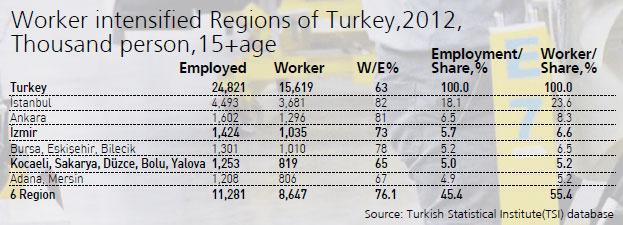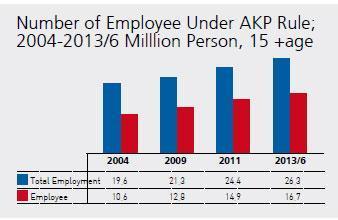Wage workers constitute two-thirds of total workforce, most unregistered
MUSTAFA SÖNMEZ

Among 2.7 million “officially unemployed” people, there is no unemployed person who gives up all hopes of finding a real job so working only temporarily in bad working conditions. The state does not count them.
There are around 17 million official wage workers in Turkey, constituting 63.5 percent of the total workforce of 26.3 million people, as of June 2013. When 2.5 million officially unemployed people, sometimes called “auxiliary” workers, and at least 1.5 million “non-counted workers” are added to the equation, we reach 21 million wage workers, 82 percent of the total workforce in Istanbul, which is really huge.Wage workers, namely blue collars, white collars, public workers, and all people who work in the agricultural, industrial, construction or services sectors, constitute the majority of Turkey’s workforce, even increasing year by year. World-renown poet Nazım Hikmet once wrote the following poem for them: “They (i.e. Wage workers) are more than fish in water, birds in air in numbers.”
Rapid proletarianization
We have seen a rapid proletarianization trend in Turkey since the AKP came to rule. While there were around 10.6 million wage workers in 2004, the number increased to 15 million in 2011. The number of wage workers has now reached 17 million as of the middle of 2013 with the addition of seasonal workers in several sectors, like agriculture, tourism and construction.
A majority of unqualified or semi-qualified, men or women, workers left their small towns in which they couldn’t find a job, then moving to big cities to take the advantage of Turkey’s annual growth of 5 percent on average, resulting from around $400 billion of foreign capital inflow to the country for the last decade. They were really employed in various labor-intensive sectors, including construction, tourism, services, and textiles, becoming wage workers. They worked by not thinking too much about their unpleasant working conditions, low wages or social insecurities.
 Among all wage workers, some 3.5 million work in the public sector: 2.6 million of them work as “public workers with temporary contracts” (as per Article 4/C of the Employment Law), and some 850,000 people work as public employees. They are registered workers. Some 3.5 million of the remaining 13.5 million wage workers are however uncovered by any social security bodies. Namely, one of four private sector workers is unregistered, working for even the net minimum wage of 800 liras (around $400). The number of unemployed people has exceeded 2.7 million in Turkey as of June 2013, representing 10 percent. Non-agricultural unemployment is around 12 percent, although the rate of unemployment is around 19 percent among young people.
Among all wage workers, some 3.5 million work in the public sector: 2.6 million of them work as “public workers with temporary contracts” (as per Article 4/C of the Employment Law), and some 850,000 people work as public employees. They are registered workers. Some 3.5 million of the remaining 13.5 million wage workers are however uncovered by any social security bodies. Namely, one of four private sector workers is unregistered, working for even the net minimum wage of 800 liras (around $400). The number of unemployed people has exceeded 2.7 million in Turkey as of June 2013, representing 10 percent. Non-agricultural unemployment is around 12 percent, although the rate of unemployment is around 19 percent among young people. Being unemployed, under no social coverage
Among 2.7 million “officially unemployed” people, there is no unemployed person who gives up all hopes of finding a real job so working only temporarily in bad working conditions. The state does not count them. The Turkish Confederation of Employers’ Unions (TİSK) has recently announced that Turkey’s unemployment rate was around 17 percent when people can be defined under “comprehensive unemployed group.”
The biggest threat for wage workers is to be under no security coverage. Of 12.5 million private sector workers, 3.7 million are unregistered, under no security coverage. This means one of three private sector workers is unregistered. Such unregistered employment is very common in services especially, including health, tourism, retail and transportation. Many Turkish people and thousands of illegal immigrant workers from the neighboring countries work in such sectors for a wage even under minimum wage and without any coverage.
The more common the working registration becomes in Turkey, the more taxes are in the Ministry of Finance.
 Furthermore, the government has long worked on various micro packages that will decrease labor costs more, such as a “flexible working system” package. Some planned packages, which put some limits on the right of severance pay and many retirement gains in focus, guarantee “being under social security coverage” for workers, but enable employers to decrease labor costs significantly, saying “Pay for the hours you make them work, not for eight hours.” The system of severance pay, which plays role in discouraging employers from firing workers among others, is planned to be transferred to a fund. Such a change brings in more flexibility for employers to fire workers to hire others. All sectors will also gain higher compatibility power to export more goods and services by declining their labor costs significantly.
Furthermore, the government has long worked on various micro packages that will decrease labor costs more, such as a “flexible working system” package. Some planned packages, which put some limits on the right of severance pay and many retirement gains in focus, guarantee “being under social security coverage” for workers, but enable employers to decrease labor costs significantly, saying “Pay for the hours you make them work, not for eight hours.” The system of severance pay, which plays role in discouraging employers from firing workers among others, is planned to be transferred to a fund. Such a change brings in more flexibility for employers to fire workers to hire others. All sectors will also gain higher compatibility power to export more goods and services by declining their labor costs significantly. Istanbul’s wage worker army
While the share of wage workers in Turkey’s total workforce is around 63 percent, the same share is over 82 percent in Istanbul, which realized 27 percent of the country’s national income by itself.
In other words, eight of 10 are wage workers in Istanbul, which hosts 18 percent of all employed people in Turkey. This means around 24 percent of all wage workers live in Istanbul.A majority of production facilities of Istanbul-based corporations are in the neighboring cities of Istanbul, including Kocaeli and Bursa. While Bursa and its southern area takes 5.2 percent from the total employment, around 78 percent of the total workforce in the area is employed on wages, very close to Istanbul. They are followed by Kocaeli and the surroundings with 68 percent, 5 points higher than the Turkey average.
The capital Ankara’s share in Turkey’s national income is 9 percent, and eight of 10 workers are wage workers, just like the case in Istanbul.
The Aegean city of İzmir has the second largest private sector-based economy, having 6.5 percent in the national income and around 6 percent in the total employment. Every 73 of 100 workers are employed for wage. These are followed by the southern cities of Adana and Mersin, in which every 67 of 100 workers are employed for wage.
















